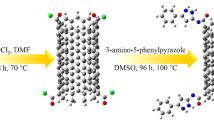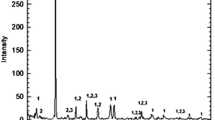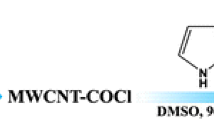Abstract
Carbon-based nanomaterials with functionalized surface are widely used in water treatment, agriculture, hydrogen storage, and biology. The current study deals with characterization of engineered multi-wall carbon nanotubes (MWCNT) prior and after chemical modification in nitric acid for 1 and 2 h. It was shown that MWCNT surface area increased from 70 m2/g (pristine material) to 149 m2/g after 2 h modification, and the surface became hydrophilic. According to back-titration method the functional surface group concentration increased almost three times after 2 h treatment compared to 1 h modification. The results of thermogravimetric analysis (TGA) have shown good correspondence with functional COOH-group concentration of samples. Total pore volume and specific surface area were calculated using non-local density functional theory (NLDFT) and Brunaeur-Emmet-Teller (BET) models. Studied functionalized MWCNTs form stable water dispersions and show great potential for biological agricultural applications.
Similar content being viewed by others
Explore related subjects
Discover the latest articles, news and stories from top researchers in related subjects.Avoid common mistakes on your manuscript.
1 Introduction
Functionalized carbon nanotubes already found some promising applications in agriculture and biology. Functionalization with –COOH groups is an important step to obtain suspensions stable in water medium, which is required for most biological applications. In agriculture functionalized carbon nanotubes could be used as fertilizers increasing plat growth rate by providing additional source of carbon to the plat. Moreover, some studies show that carbon nanotubes could impede microbial-root interactions causing toxicity to microbes [1]. Biological applications of CNTs mostly focused on transport properties [2].
The discovery of carbon nanotubes (CNT) in 1991 by Iijima [3] has stimulated research on large variety of physical properties of the nanotubes. Carbon nanotubes are formed by rolled graphite sheets. Tubes formed by only one graphite layer are called single wall carbon nanotubes (SWCNT). Tubes consisting of multiple concentric graphite layers are called multi-wall carbon nanotubes (MWCNT).
Since 1997, many research groups have studied the storage of hydrogen in carbon graphite samples of various shapes as well as carbon nanotubes. Dillon et al. [4] reported for first time excellent hydrogen storage properties of CNT. He estimated the hydrogen storage capacity of SWCNT to range between 5 and 10 mass% of the sample. A promising sorbing material exhibited the potential to meet the storage requirements designated by the US Department of Energy (DOE)—gravimetric adsorption capacity of hydrogen 6.5 wt%, or 65 g H2/kg C [5].
The adsorption results are based on several types of bonding between carbon and hydrogen. The adsorption is due to physisorption, and either chemisorption or an intermediate state between physisorption and chemisorption. Experimental and theoretical studies devoted to the investigation of the possible mechanisms of H2 adsorption on various types of CNTs have been also reported in the literature [6,7,8,9,10,11,12,13,14].
Although numerous experimental studies have been carried out to obtain physical adsorption isotherms of H2 on different porous solids over a wide range of thermodynamic conditions [15,16,17], the majority of them is directly related to the excess surface adsorption isotherms and only a few studies were devoted to determine the total or absolute adsorption isotherms [18]. The surface excess adsorption results cannot serve for comparison with theoretical predictions. A necessity arises to employ a method for the calculation of total adsorption isotherms based on experimental surface excess adsorption data obtained over a given gas phase pressure regime.
When experimentally measuring the adsorbed amount of hydrogen, a probe gas, requiring zero interactions with the adsorbent (usually helium), has to be dosed onto the sample initially in order to calculate the available space. Following removal of the probe gas, a known volume of hydrogen is dosed onto the sample and the additional amount of hydrogen in the system above that of the probe gas volume is calculated. Therefore, the excess is the additional amount of hydrogen in the system due to the interactions with the adsorbent.
Pristine and functionalized carbon nanotubes could also be used for water desalination and purification as shown in multiple studies. Most of them are now focused on creating functionalized carbon materials precisely tuned for selective purification [19,20,21,22,23,24,25,26,27].
2 Materials and Methods
The multi-wall carbon nanotubes (MWCNT) samples were synthesized in a vacuum furnace at 920 K by pyrolysis of acetylene (12 vol% acetylene in nitrogen) [28]. The MWCNT samples are characterized by specific surface area of 300 m2/g and bulk density of 0.03–0.05 g/cm3. Multi-wall carbon nanotubes surface treatment was done by boiling MWCNTs in concentrated nitric acid (HNO3) for 1 and 2 h with MWCNT/acid ratio equal to 1/20. Oxidation process was carried out in two-necked flask with backflow condenser and thermometer to control the reaction temperature between 100 and 105 °C. Reaction products were rinsed with distilled (DI) water until neutral pH. Separation of reaction products was done by decantation with subsequent vacuum filtering and drying at 60 °C for 48 h.
Functional group concentration was measured by acid-base back-titration. MWCNTs were covered with sodium hydroxide solution of the known concentration and left for 24 h. The precipitate was filtered on the paper filter, and then the aliquot was mixed with hydrogen chloride solution with subsequent titration with sodium hydroxide. The pH value was measured by a pH-meter “Anion-4100” with absolute error of ± 0.02. Specific surface area and pore-size distribution data was obtained from low temperature nitrogen adsorption measurements done with Quantachrome Nova 1200e instrument. Pore-size distribution was calculated using NovaWin software NLDFT method based on nitrogen on carbon adsorption model.
Optical properties were analyzed by Fourier-transform Infrared spectrometry (FTIR) using Thermo Nicolet 380 instrument in transmittance mode.
Thermal stability and decomposition kinetics were studied using thermogravimetric analyzer TA SDT Q600. Experiment was done in a ramp mode from 25 to 800 °C with heating rate set to 10 °C/min and in a 100 ml/min flow of dry air. The thermogravimetric analysis (TGA) measures the change in mass of a sample as function of temperature. This is particularly important for porous materials, as it provides the temperature boundaries within which the solvent can be removed from the pores, as well as indication of the composition and temperature stability of the material.
3 Results and Discussion
Measured with acid-base back-titration values of functional group concentration for two samples treated in concentrated HNO3 for 1 and 2 h are shown in Table 1.
Table 1 shows that longer treatment time result in higher functional group content which increased almost three times while treated for one additional hour. Higher total pore volume is explained by MWCNT structure degradation as a result of oxidation treatment.
Water suspension stability was tested by comparing absorption of pristine and functionalized MWCNT samples after 120 h of decantation (Fig. 1). Prior to decantation samples were treated with ultrasound for 5 min. Concentration for all three samples was 0.001 wt%
As seen in Fig. 1, functionalized MWCNT show much better stability over time and does not flocculate as pristine MWCNT even after 120 h of decantation. This is due to hydrophilic nature of COOH-functional groups formed by oxidative treatment. The nature of functional groups was analyzed using FTIR method.
According to FTIR results (Fig. 2), functionalized MWCNT show more intense –OH band (around 3440 cm−1) and additional bands at 1635 and 1710 cm−1 which were attributed to carboxylate anion vibrations. The similar results have been also reported in the literature [29,30,31].
Pore-size distribution data for the MWCNT-0.238 sample is shown in Figs. 3 and 4. As seen in Fig. 3, at least five peaks are present on dV(HPW) curve which corresponds five different pore volumes preferable for nitrogen adsorption (1.6, 2.4, 3.8, 4.5, and 5.6 nm). This fact shows that those half-pore width values correspond to different MWCNT diameters. Average pore volume for that sample is 0.372 cm3/g.
Fig. 5 shows cumulative pore volume (V) and dV values plotted against half-pore width for the sample MWCNT 0.65. It should be noted that dV curve has five peaks, which could be correlated with 1.62, 2.4, 2.8, 3.8, and 4.55 nm pores. Average pore volume according to the model is 0.42 cm3/g and lower confidence limit is 1.614 nm. Pore-size histogram for this sample is shown in Fig. 6.
Figs. 7 and 8 show thermogravimetric curves for functionalized samples. MWCNT-0.238 sample which has lower functional group content also has a single peak on weight loss derivative curve that is attributed to MWCNT conversion to CO2 in oxidation process. Total weight loss at 700 °C is 93%. Apparently, surface functional group with 0.238 mmol/g concentration do not contribute too much weight to the sample. Quite different situation could be seen on Fig. 6 (MWCNT 0.65 mmol/g), where three peaks on weight derivative curve are found. First peak from 80 to 100 °C could be due to adsorbed water evaporation, which is anticipated, mostly because of higher hydrophilic group content on the sample surface. Small second peak could be caused by salt residue decomposition. Third peak on weight derivative curve for MWCNT 0.65 mmol/g is attributed to MWCNT conversion to CO2 in oxidation process. It should be noted, that for this sample higher COOH-group content causes the oxidation and MWCNT structure degradation processes to start at lower temperature compared to the sample treated for the shorter time. Weight loss process for both samples ends at 650 °C.
Higher total pore volume and different thermal decomposition parameters could also be caused by MWCNT structure degradation. The longer the oxidative treatment the higher is defects concentration and surface area values.
4 Conclusions
In this study, we have shown the one-step chemical modification of MWCNT surface that results in the different COOH-group content on the nanotubes surface. The longer treatment times lead to higher total pore volume and higher specific surface area calculated both with BET and DFT models. Specific surface area value for the sample treated for 1 h was calculated to be 131 m2/g and for the sample treated for 2 h is 149 m2/g. The functional COOH-group concentration for samples was obtained by back-titration method. Higher COOH-group content for MWCNT-0.65 sample than COOH-group content for MWCNT-0.238 is in good correspondence with thermogravimetric data. It should be also noted that increase in oxidative treatment time not only increases functional surface group concentration but also changes carbon nanotube surface from hydrophobic to hydrophilic. Functionalized MWCNTs produce stable over a long period of time water dispersions which could be used in biology and agriculture.
References
Canas, J. E., Long, M., Nations, S., Vadan, R., Dai, L., & Luo, M. (2008). Effects of functionalized and nonfunctionalized single-walled carbon nanotubes on root elongation of select crop species. Environmental Toxicology and Chemistry, 27, 1922–1931. doi:10.1897/08-117.1.
Yang, W., Thordarson, P., Gooding, J. J., Ringer, S. P., Filip, B. F. (2007). Carbon nanotubes for biological and biomedical applications. Nanotechnology, 41, 412001. doi: 10.1088/0957-4484/18/41/412001.
Iijima, S. (1991). Helical microtubules of graphitic carbon. Nature, 354, 56–58. doi:10.1038/354056a0.
Dillon, A. C., Jones, K. M., Bekkedahl, T. A., Kiang, C. H., Bethune, D. S., & Heben, M. J. (1997). Storage of hydrogen in single-walled carbon nanotubes. Nature, 386, 377–379. doi:10.1038/386377a0.
Hynek, S., Fuller, W., & Bentley, J. (1997). Hydrogen storage by carbon sorption. International J. Hydrogen Energy, 22, 601–610. doi:10.1016/S0360-3199(96)00185-1.
Dresselhaus, M., Williams, K. A., & Eklund, P. C. (1999). Hydrogen adsorption on carbon materials. MRS Bulletin, 24, 45–50. doi:10.1557/S0883769400053458.
Wang, Q., & Johnson, J. K. (1998). Molecular simulation of hydrogen adsorption in single-walled carbon nanotubes and idealized carbon slit pores. J. Chemical Physics, 110, 577–586. doi:10.1063/1.478114.
Darkrim, F., & Levesque, D. (1998). Monte Carlo simulations of hydrogen adsorption in single-walled carbon nanotubes. J. Chemical Physics, 109, 4981–4984. doi:10.1063/1.477109.
Gu, C., Gao, G. H., & Yu, Y. X. (2004). Density functional study of the adsorption and separation of hydrogen in single-walled carbon nanotube. International J. Hydrogen Energy, 29, 465–473. doi:10.1016/S0360-3199(03)00131-9.
Darkrim, F. L., Malbrunot, P., & Tartaglia, G. P. (2002). Review of hydrogen storage by adsorption in carbon nanotubes. International J. Hydrogen Energy, 27, 193–202. doi:10.1016/S0360-3199(01)00103-3.
Meregalli, V., & Parrinello, M. (2001). Review of theoretical calculations of hydrogen storage in carbon-based materials. Applied Physics A: Materials Science & Processing, 72, 143–146. doi:10.1007/s003390100789.
Ye, Y., Ahn, C. C., Witham, C., Fultz, B., Liu, J., Rinzler, A. G., Colbert, D., Smith, K. A., & Smalley, R. E. (1999). Hydrogen adsorption and cohesive energy of single-walled carbon nanotubes. Applied Physics Letters, 74, 2307–2310. doi:10.1063/1.123833.
Liu, C., Fan, Y. Y., Liu, M., Cong, H. T., Cheng, H. M., & Dresselhaus, M. S. (1999). Hydrogen storage in single-walled carbon nanotubes at room temperature. Science, 286, 1127–1129. doi:10.1126/science.286.5442.1127.
Ioannatos, G. E., & Verykios, X. E. (2010). H2 storage on single- and multi-walled carbon nanotubes. International J. Hydrogen Energy, 35, 622–628. doi:10.1016/j.ijhydene.2009.11.029.
Kuznetsova, A., Mawhinney, D. B., Naumenko, V., Yates Jr., J. T., Liu, J., & Smalley, R. (2000). Enhancement of adsorption inside of single-walled nanotubes: Opening the entry ports. Chemical Physics Letters, 321, 292–296. doi:10.1016/S0009-2614(00)00341-9.
Cheng, H., Cooper, A. C., Pez, G. P., Kostov, M. K., Piotrowski, P., & Stuart, S. J. (2005). Molecular dynamics simulations on the effects of diameter and chirality on hydrogen adsorption in single walled carbon nanotubes. J. Physical Chemistry B, 109, 3780. doi:10.1021/jp045358m.
Miyawaki, J., & Kaneko, K. (2001). Pore width dependence of the temperature change of the confined methane density in slit-shaped micropores. Chemical Physics Letters, 337, 243–247. doi:10.1016/S0009-2614(01)00225-1.
Salem, M. M. K., Braeuer, P., Szombathely, M., Heuchel, M., Harting, P., Quitzsch, K., & Jaroniec, M. (1998). Thermodynamics of high-pressure adsorption of argon, nitrogen and methane on microporous adsorbents. Langmuir, 14, 3376–3389. doi:10.1021/la970119u.
Saleh, T. A. (2016). Nanocomposite of carbon nanotubes/silica nanoparticles and their use for adsorption of Pb(II): From surface properties to sorption mechanism. Desalination and Water Treatment, 57, 10730–10744. doi:10.1080/19443994.2015.1036784.
Saleh, T. A. (2015). Mercury sorption by silica/carbon nanotubes and silica/activated carbon: A comparison study. Journal of Water Supply: Research and Technology-AQUA, 64, 892–903. doi:10.2166/aqua.2015.050.
Saleh, T. A. (2015). Isotherm, kinetic, and thermodynamic studies on hg(II) adsorption from aqueous solution by silica- multiwall carbon nanotubes. Environmental Science and Pollution Research, 22, 16721–16731. doi:10.1007/s11356-015-4866-z.
Saleh, T. A. (2011). The influence of treatment temperature on the acidity of MWCNT oxidized by HNO3 or a mixture of HNO3/H2SO4. Applied Surface Science, 257, 7746–7751. doi:10.1016/j.apsusc.2011.04.020.
Sani, H. A., Ahmada, M. B., & Saleh, T. A. (2016). Synthesis of zinc oxide/talc nanocomposite for enhanced lead adsorption from aqueous solutions. RSC Advances, 6, 108819–108827. doi:10.1039/C6RA24615J.
Saleh, T. A., Al-Shalalfeh, M. M., & Al-Saadi, A. A. (2016). Graphene dendrimer-stabilized silver nanoparticles for detection of methimazole using surface-enhanced Raman scattering with computational assignment. Scientific Reports, 6, 32185. doi:10.1038/srep32185.
Danmaliki, G. I., & Saleh, T. A. (2017). Effects of bimetallic Ce/Fe nanoparticles on the desulfurization of thiophenes using activated carbon. Chemical Engineering Journal, 307, 914–927. doi:10.1016/j.cej.2016.08.143.
Saleh, T. A., Sarı, A., & Tuzen, M. (2017). Effective adsorption of antimony (III) from aqueous solutions by polyamide-graphene composite as a novel adsorbent. Chemical Engineering Journal, 307, 230–2382. doi:10.1016/j.cej.2016.08.070.
Zare, F., Ghaedi, M., Daneshfar, A., Agarwal, S., Tyagi, I., Saleh, T. A., & Gupta, V. K. (2016). Efficient removal of radioactive uranium from solvent phase using AgOH–MWCNTs nanoparticles: Kinetic and thermodynamic study. Chemical Engineering Journal, 273, 296–306. doi:10.1016/j.cej.2015.03.002.
Muratov, D. S., & Gromov, S. (2017). Evaluating hydrogen uptake for two types of multi-wall carbon nanotubes from nitrogen adsorption/desorption data. Nano Hybrids and Composites, 13, 341–347. doi:10.4028/www.scientific.net/NHC.13.341.
Le, V. T., Ngo, C. L., Le, Q. T., Ngo, T. T., Nguyen, D. N., & Vu, M. T. (2013). Surface modification and functionalization of carbon nanotube with some organic compounds. Advances in Natural Sciences: Nanoscience and Nanotechnology, 4, 035017(5pp). doi:10.1088/2043-6262/4/3/035017.
Ahmeda, D. S., Haiderb, A. J., & Mohammad, M. R. (2013). Comparesion of functionalization of multi walled carbon nanotubes treated by oil olive and nitric acid and their characterization. Energy Procedia, 36, 1111–1118. doi:10.1016/j.egypro.2013.07.126.
Athmouni, N., Mighri, F., & Elkoun, S. (2016). Effect of unfunctionalized and HNO3-functionalized MWCNT on the mechanical and electrical performances of PEMFC bipolar plates. Journal of Applied Polymer Science, 133, 43624–43631. doi:10.1002/app.43624.
Acknowledgements
This work was supported by the Federal Target Program “Investigations and developments along priority avenues for the advancement of science and technology of Russia in the 2014–2020 period” (grant agreement no. 14.575.21.0087 dated 21.10.2014, Project ID-RFMEFI57514X0087).
Author information
Authors and Affiliations
Corresponding author
Rights and permissions
About this article
Cite this article
Muratov, D.S., Stolyarov, R.A. & Gromov, S.V. Surface Structure and Adsorption Characteristics of COOH-Functionalized Multi-Wall Carbon Nanotubes. BioNanoSci. 8, 668–674 (2018). https://doi.org/10.1007/s12668-017-0442-y
Published:
Issue Date:
DOI: https://doi.org/10.1007/s12668-017-0442-y












